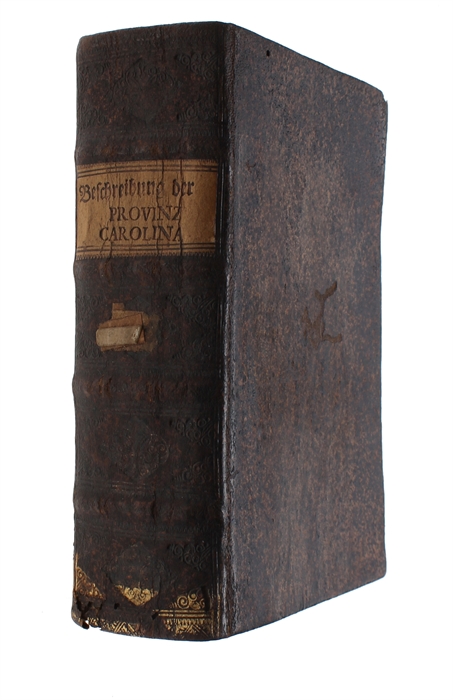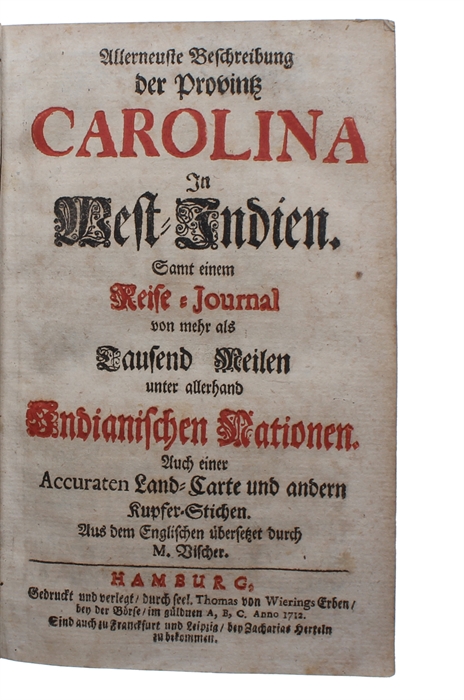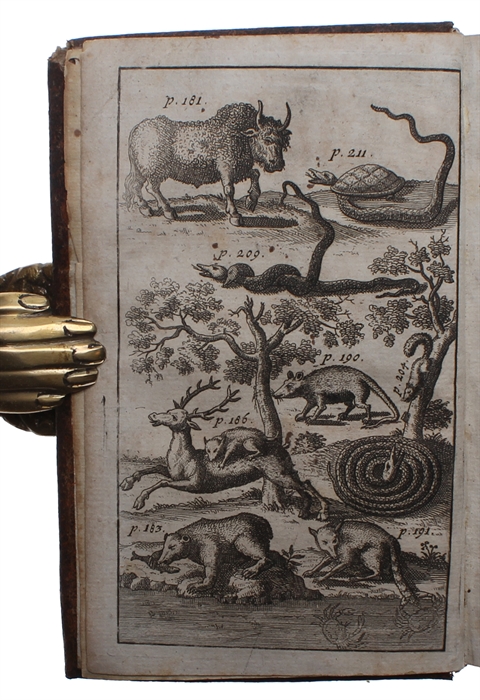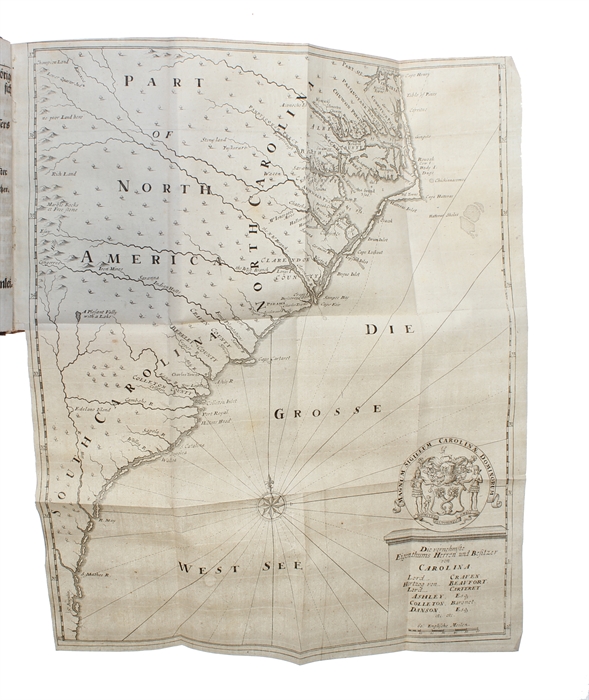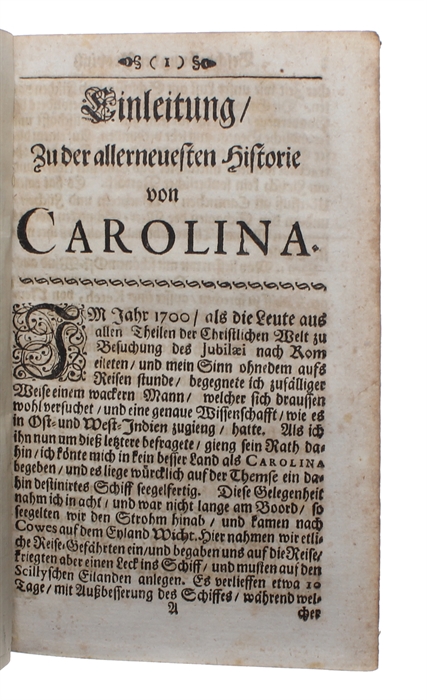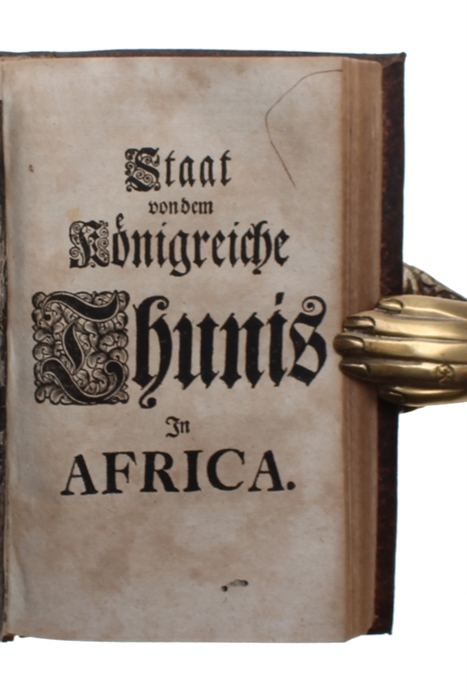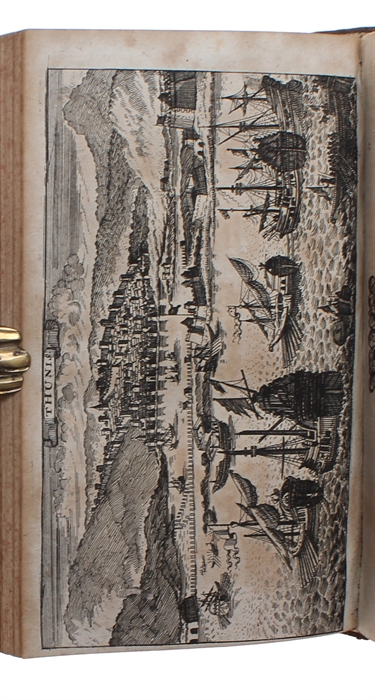FIRST TRANSLATION OF "THE FIRST HISTORY OF CAROLINA"
(LAWSON, JOHN).
Allerneuste Beschreibung der Provintz Carolina In West-Indien. Samt einem Reise-Journal von mehr als Tausend Meilen unter allerhand Indianischen Nationen. Auch einer Accuraten Land-Carte und andern Kupfer-Stichen. Aus dem Englischen übersetzet (withbond is: Caspar Gottschling's 'Staat von Egypten', 'Staat von dem Königreiche Thunis In Africa' & 'Staat von dem Königreiche Algier In Africa'.
Hamburg,von Wiering, 1712.
8vo. In contemporary full calf with four raised bands. Embossed ornamentation to spine. Lower part of back hindge and back board with worm hole. Last three works with small wormtract to lower part of leaves (not affecting Lawson's work, other wise a good copy. [Lawson:] (14), 365, (3) pp. + frontispiece and 1 folded map; (4), 239, (5); (2), 94; (2), 134 pp.
The exceedingly rare first German translation of "the first history of Carolina, with a very observant report of the life, customs, and natural history of the colony" (Streeter). John Lawson’s work offers a largescale portrayal of the customs and traditions of the Native American tribes during that era, while also serving as a meticulous record of the Carolinas' geography, climate, flora, fauna, and aquatic life, it constitute one of the most valuable contributions to the early history of Carolina and is considered to be one of the first travel account of the early 18th-century colonies. Lawson’s book provided a meticulous account of his 550-mile, 57-day journey through the backcountry of what would eventually become the states of both South Carolina and North Carolina. Beginning in the port city of Charles Town in December 1700, Lawson and nine other adventurers traveled northwestward toward present-day Charlotte, North Carolina. From there he explored the Piedmont basins of the Catawba and Yadkin Rivers before turning eastward toward present-day Bath, arriving there late in February 1701. John Lawson (1674 - 1711) was an English explorer, adventurer and writer. From 1700 onwards, Lawson was instrumental in the exploration and development of the northern part of what was then the British colony of Carolina, today's US state of North Carolina. Little is known about Lawson's life before his arrival in Carolina. In 1700 he traveled to America and arrived in Charleston where Lawson began a two-month expedition by canoe up the Santee River with five other British and various Indian guides to explore the then unknown land north of Charleston. The expedition ended about 1,000 kilometers further north at the mouth of the Pamlico River (now in Beaufort County). During the expedition, Lawson took extensive notes, which eventually was published in the present work. After the expedition ended, Lawson acquired land in the area where the expedition had ended and worked there, first privately and then on behalf of the colonial administration as a surveyor. At this point, a few scattered Europeans had already settled in the area. Lawson's holdings grew into North Carolina's first permanent settlement, Bath, which soon prospered and became North Carolina's most important port of entry. Lawson was involved with the Swiss Christoph von Graffenried and Franz Ludwig Michel in the founding of North Carolina's second oldest city, New Bern, by Swiss and German immigrants in 1710. Lawson was kidnapped and subsequently killed by the Tuscarora in 1711 after they noticed that Lawson had tried to take advantage of them in a trade. This event led to a deterioration in the climate between the Europeans and the Tuscarora and thus contributed to the outbreak of the Tuscarora War, which, after the initial successes of the Tuscarora, ended with their expulsion. Sabin 39453
Order-nr.: 60524

